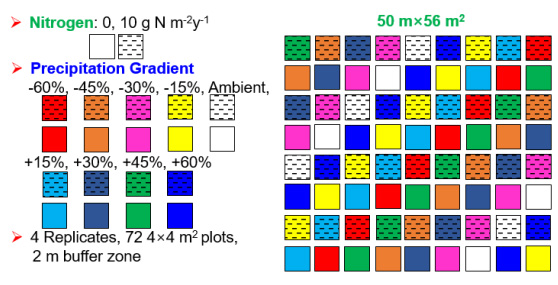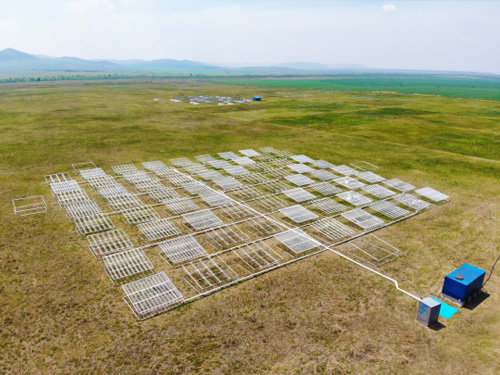Scientific Question
Concurrent with climate warming, the Earth System Models have projected an intensification of global hydrological cycling, with consequence for amplified precipitation inter-annual variability and more frequent extreme precipitation events (Wet or drought). Grasslands account for approximate 26% of the total land area on Earth, and contribute substantially to global carbon (C) budget. Plant growth and C cycling in grasslands have well been revealed to be primarily driven by soil available water. With the increasing frequency of extreme precipitation events, grassland productivity is suggested to show nonlinear concave-down relationship with precipitation amount. One of the major underlying mechanisms that is considered to drive the saturating response is nitrogen (N) limitation. However, there still lacks sufficient evidences to support the nonlinear response and N limitation hypothesis. In order to investigate the response of grassland ecosystem C cycling to extreme precipitation and examine whether N limitation would alter their relationship, a field experiment including nine levels of precipitation treatments (−60%, −45%, −30%, −15%, ambient, +15%, +30%, +45%, and +60%) and two levels of N addition treatments (0 and 10 g N m-2 yr-1) was conducted in a semiarid grassland on Mongolia Plateau.
Experimental Design
The experiment used a Latin square design. Seventy-two 4 × 4 m plots with 2 m buffer zone among plots were selected and arranged in a 8 × 9 matrix in May 2019. The plots were assigned randomly to one of the nine levels of precipitation treatments: −60% (P−60), −45% (P−45), −30% (P−30), −15% (P−15), 0% (control, C), +15% (P+15), +30% (P+30), +45% (P+45), and +60% (P+60) of ambient precipitation. Half of the precipitation treatment plots received no nitrogen (N), but the other thirty-six plots was added at the rate of 10 g N m-2 y-1 (NP−60, NP−45, NP−30, NP−15, N, NP+15, NP+30, NP+45, NP+60). Each treatment had four replicates (blocks). All the measurements were conducted in 3 × 3 m central area of each plot to reduce any possible edge effects.
In the decreased precipitation treatment plots, the V-shaped rainout shelters were used to intercept different amounts of rainfall. In addition, in the control and increased precipitation plots, inverted V-shaped rainout shelters with small holes were installed to eliminate the potential shading effects of rainout shelters. After each precipitation event, the precipitation amount was immediately obtained from the rain gauge (<10 m) near the experimental site. The collected rainwater was manually sprayed into the increased precipitation plots to avoid changing the precipitation frequency. Since 2019, both N and precipitation treatments were conducted during 4 months (June to September which account for 78% of annual precipitation) in the growing seasons, and N was added to the plots at the rate of 2.5 g m-2 in each month.



